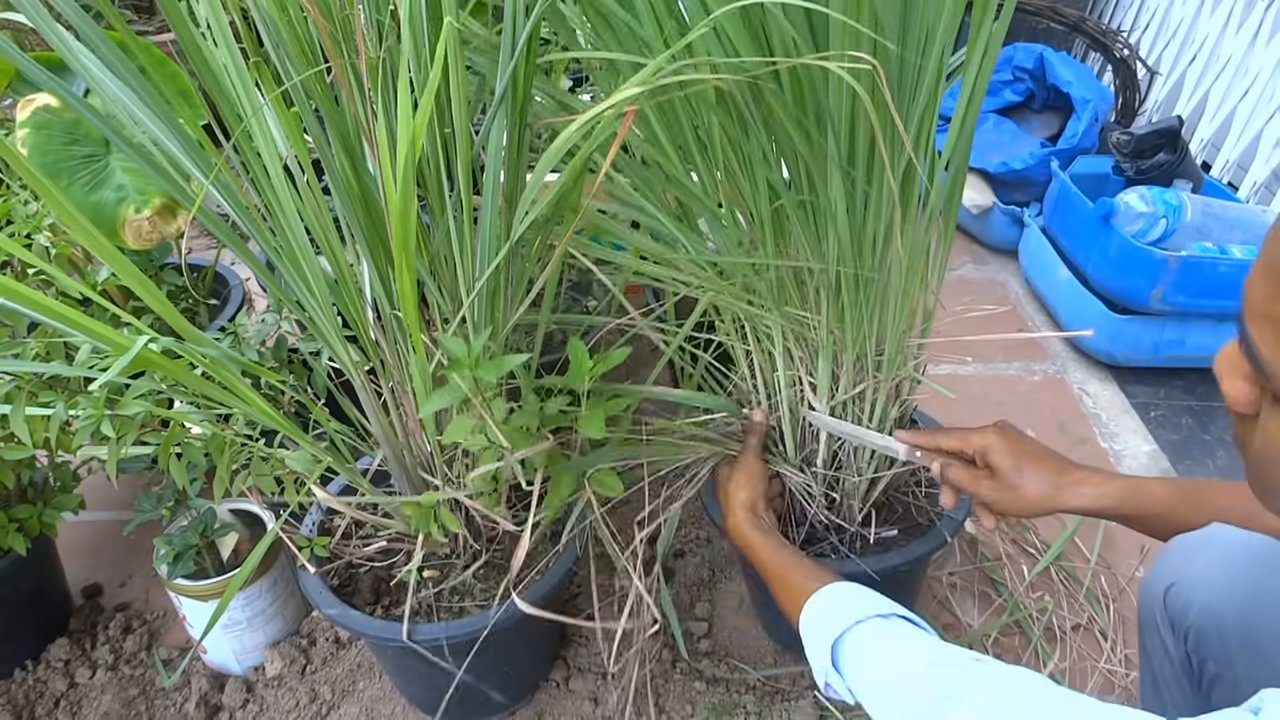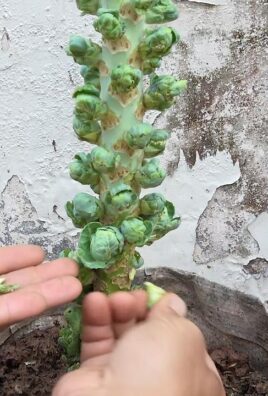Grow Lemongrass Indoors and bring a touch of Southeast Asian sunshine right into your home! Have you ever dreamt of snipping fresh, fragrant lemongrass straight from your windowsill to infuse your soups, teas, and curries with that unmistakable citrusy zing? Well, dream no more! This DIY guide will unlock the secrets to successfully cultivating this tropical treasure indoors, regardless of your gardening experience.
Lemongrass, deeply rooted in Asian culinary traditions, has been used for centuries not only for its delicious flavor but also for its medicinal properties. From ancient Ayurvedic practices to modern aromatherapy, this versatile herb has a rich history. But you don’t need to travel to a tropical climate to enjoy its benefits.
Why should you learn to grow lemongrass indoors? Simple! Fresh lemongrass from the grocery store can be expensive and often lacks the vibrant flavor of homegrown. Plus, cultivating your own herbs is incredibly rewarding and adds a touch of green to your living space. Imagine the satisfaction of knowing exactly where your ingredients come from and the joy of having a readily available supply of this amazing herb. I’m here to guide you through the process, step-by-step, with easy-to-follow instructions and helpful tips to ensure your indoor lemongrass thrives. Let’s get started!

Growing Lemongrass Indoors: A DIY Guide for Fresh Flavor All Year Round
I love the fresh, lemony scent and taste of lemongrass! It’s a must-have in my kitchen for Thai curries, soups, and even teas. But buying lemongrass at the supermarket can be expensive, and it’s often not as fresh as I’d like. That’s why I decided to grow my own lemongrass at home, and I can tell you, it’s easier than you think! Here is my step-by-step guide on how you can do it too:
What you need:
- Lemongrass stalks: Buy fresh lemongrass stalks at the supermarket or an Asian grocery store. Make sure they look healthy and have a small root base. The fresher, the better!
- A glass of water: A simple drinking glass is perfectly fine.
- A planter: Choose a pot with a diameter of at least 15 cm (6 inches). Lemongrass needs space to grow.
- Potting soil: Use a high-quality potting soil that drains well. I prefer a mixture of potting soil, compost, and perlite.
- A sunny location: Lemongrass loves the sun! A windowsill with direct sunlight is ideal.
- Optional: Liquid fertilizer for herbs.
Rooting Lemongrass: The First Step to Success
This step is crucial to ensure that your lemongrass establishes well in the pot. We will first root the stalks in water.
- Prepare the lemongrass: Cut off the top green leaves of the lemongrass, leaving only about 10-15 cm (4-6 inches) of the stalk. This helps the plant focus on root formation.
- Place in water: Put the lemongrass stalks in the glass with water. Make sure the root base (the bottom end of the stalk) is in the water.
- Sunny location: Place the glass in a sunny spot, e.g., on a windowsill.
- Change the water: Change the water every few days to keep it fresh and clean.
- Be patient: After about 2-3 weeks, you should see small roots growing from the root base. Wait until the roots are at least 2-3 cm (1 inch) long before you plant the lemongrass in soil.
Planting Lemongrass: A New Home for Your Plant
Once the roots are well-developed, it’s time to plant your lemongrass in a pot.
- Prepare the pot: Fill the pot with potting soil. Leave about 2-3 cm (1 inch) of space at the top of the pot.
- Dig a planting hole: Dig a small hole in the center of the soil, large enough to accommodate the roots of the lemongrass.
- Insert the lemongrass: Carefully place the lemongrass in the hole and cover the roots with soil. Gently press the soil down.
- Water: Water the lemongrass thoroughly until water runs out of the pot’s drainage holes.
Caring for Lemongrass: How to Keep Your Plant Happy and Healthy
Proper care is crucial for your lemongrass to grow well indoors and bring you joy for a long time.
- Location: Place the pot in a sunny location. Lemongrass needs at least 6 hours of sunlight per day. If you don’t have enough sunlight, you can use a grow light.
- Watering: Water the lemongrass regularly, but avoid waterlogging. The soil should always be slightly moist. Check the soil’s moisture by sticking your finger about 2-3 cm (1 inch) deep into it. If the soil feels dry, it’s time to water.
- Fertilizing: Fertilize the lemongrass every 2-3 weeks with a liquid fertilizer for herbs. Follow the instructions on the fertilizer’s packaging.
- Pruning: Regularly cut off dry or brown leaves to promote the plant’s growth. You can also trim the top leaves to make the plant bushier.
- Repotting: When the pot becomes too small, you will need to transplant the lemongrass into a larger pot. You’ll know it’s time to repot when the roots grow out of the pot’s drainage holes or the plant isn’t growing as well.
- Pests: Watch out for pests like aphids or spider mites. If you find pests, you can combat them with an insecticide or a soap solution.
Harvesting Lemongrass: The Reward for Your Effort
After about 3-4 months, you should be able to harvest your first lemongrass.
- Harvesting: Cut the stalks of the lemongrass with a sharp knife or scissors. Cut the stalks as close to the ground as possible.
- Using: You can use the lemongrass immediately or store it in the refrigerator. To make the lemongrass last longer, you can also freeze it.
- Enjoying: Enjoy the fresh, lemony taste of your homegrown lemongrass in your favorite dishes!
Common Problems and Solutions:
- Yellow leaves: Yellow leaves can be a sign of overwatering, underwatering, or a nutrient deficiency. Check the soil’s moisture and fertilize the plant if necessary.
- Brown leaf tips: Brown leaf tips can be a sign of dry air. Spray the leaves regularly with water or place the pot on a saucer with water and pebbles.
- Slow growth: Slow growth can be a sign of too little sunlight or a nutrient deficiency. Move the plant to a sunnier location and fertilize it regularly.
- Pests: Watch out for pests like aphids or spider mites. If you find pests, you can combat them with an insecticide or a soap solution.
Additional Tips for Success:
- Use filtered water: Tap water can contain chlorine and other chemicals that can be harmful to the lemongrass. Use filtered water or let the tap water sit for 24 hours before watering to allow the chlorine to evaporate.
- Rotate the pot regularly: Rotate the pot regularly so that all sides of the plant receive even sunlight.
- Be patient: Lemongrass takes time to grow. Be patient and give the plant the right care, and you will soon be rewarded with fresh, homegrown lemongrass!
- Propagation: If your lemongrass is growing well, you can propagate it by dividing the stalks. Dig the plant out of the pot and carefully divide the stalks into several parts. Plant each part in a separate pot.
I hope this guide helps you grow your own lemongrass at home! It’s a rewarding project that will bring fresh flavor and fragrance to your kitchen all year round. Good luck and have fun gardening

Conclusion
So, there you have it! Growing lemongrass indoors is not only achievable but also incredibly rewarding. Imagine having a readily available supply of fresh, fragrant lemongrass right at your fingertips, ready to elevate your culinary creations and infuse your home with its invigorating aroma. This simple DIY trick transforms a humble stalk of lemongrass into a thriving indoor plant, offering a sustainable and cost-effective alternative to constantly purchasing it from the store.
Why is this a must-try? Because it’s more than just growing a plant; it’s about embracing a greener lifestyle, connecting with nature, and adding a touch of Southeast Asian flair to your home. It’s about the satisfaction of nurturing something from a simple cutting to a flourishing herb, ready to enhance your favorite dishes. Think of the vibrant curries, the soothing teas, and the aromatic broths you can create with your homegrown lemongrass.
Beyond the culinary benefits, growing lemongrass indoors also offers a natural air freshener. Its citrusy scent can help purify the air and create a calming atmosphere in your home. Plus, it’s a beautiful addition to any indoor garden, adding a touch of greenery and texture to your living space.
Variations and Suggestions:
* Container Choice: While we recommend a well-draining pot, feel free to experiment with different materials like terracotta or ceramic. Just ensure it has adequate drainage holes.
* Soil Amendments: Consider adding a slow-release fertilizer to the soil mix to provide your lemongrass with a steady supply of nutrients.
* Lighting: If you don’t have a sunny windowsill, you can supplement with a grow light. This is especially helpful during the winter months when natural light is limited.
* Propagation: Once your lemongrass plant is established, you can propagate it by dividing the clumps. This is a great way to expand your lemongrass collection or share it with friends and family.
* Pest Control: Keep an eye out for common houseplant pests like aphids or spider mites. Treat them promptly with insecticidal soap or neem oil.
* Lemongrass Tea Blend: Experiment with different tea blends using your fresh lemongrass. Try combining it with ginger, mint, or honey for a delicious and refreshing beverage.
* Lemongrass Infused Oil: Infuse oil with lemongrass for a flavorful cooking oil or massage oil.
We wholeheartedly encourage you to try this DIY trick and experience the joy of growing lemongrass indoors. It’s a simple, rewarding, and sustainable way to add flavor and fragrance to your life. Don’t be afraid to experiment and adapt the process to suit your specific environment and preferences.
Once you’ve successfully grown your own lemongrass, we’d love to hear about your experience! Share your tips, tricks, and photos in the comments below. Let’s build a community of indoor lemongrass growers and inspire others to embrace this wonderful DIY project. Let us know if you have any questions, and happy growing!
Frequently Asked Questions (FAQ)
1. What kind of lemongrass should I buy for propagation?
Look for fresh lemongrass stalks at your local grocery store or Asian market. Choose stalks that are firm, green, and have a bulbous base with some root nubs. Avoid stalks that are dry, wilted, or have signs of rot. The healthier the stalk, the better your chances of successful propagation. Organic lemongrass is always a great choice if available.
2. How long does it take for lemongrass to root in water?
Generally, you should start seeing roots emerge within 1-3 weeks. The timeframe can vary depending on factors like water temperature, light exposure, and the overall health of the lemongrass stalk. Be patient and change the water every few days to keep it fresh and prevent bacterial growth. Once the roots are about an inch long, you can transplant the lemongrass to a pot with soil.
3. What kind of soil is best for growing lemongrass indoors?
Lemongrass thrives in well-draining soil that is rich in organic matter. A good mix would be a combination of potting soil, perlite, and compost. The potting soil provides a base for the plant to grow, the perlite improves drainage, and the compost adds essential nutrients. Avoid using heavy clay soil, as it can retain too much moisture and lead to root rot.
4. How much sunlight does indoor lemongrass need?
Lemongrass needs at least 6-8 hours of direct sunlight per day to thrive. Place your lemongrass plant near a sunny south-facing window where it can receive ample sunlight. If you don’t have a sunny window, you can supplement with a grow light. Rotate the plant regularly to ensure even growth on all sides. Insufficient sunlight can lead to leggy growth and reduced flavor.
5. How often should I water my indoor lemongrass plant?
Water your lemongrass plant when the top inch of soil feels dry to the touch. Water thoroughly until the water drains out of the bottom of the pot. Avoid overwatering, as this can lead to root rot. During the winter months, when the plant is not actively growing, you can reduce the frequency of watering.
6. How do I fertilize my indoor lemongrass plant?
Feed your lemongrass plant with a balanced liquid fertilizer every 2-4 weeks during the growing season (spring and summer). Dilute the fertilizer according to the package instructions. Avoid fertilizing during the winter months when the plant is dormant. You can also add compost to the soil to provide a slow-release source of nutrients.
7. How do I harvest lemongrass from my indoor plant?
To harvest lemongrass, simply cut off the stalks near the base of the plant. Use a sharp knife or scissors to make a clean cut. You can harvest individual stalks as needed, or you can harvest the entire plant at once. The more you harvest, the more the plant will grow.
8. Can I grow lemongrass from seed indoors?
Yes, you can grow lemongrass from seed indoors, but it’s generally more challenging than propagating from stalks. Start by sowing the seeds in a seed-starting mix and keeping them moist. Germination can take several weeks. Once the seedlings are large enough to handle, transplant them to individual pots. Growing lemongrass from seed requires more patience and attention than propagating from stalks.
9. What are some common problems when growing lemongrass indoors?
Some common problems include root rot (due to overwatering), pest infestations (such as aphids or spider mites), and nutrient deficiencies (due to lack of fertilization). To prevent root rot, ensure that the soil is well-draining and avoid overwatering. To control pests, use insecticidal soap or neem oil. To prevent nutrient deficiencies, fertilize regularly during the growing season.
10. Is lemongrass safe for pets?
While lemongrass is generally considered non-toxic to pets, it can cause digestive upset if ingested in large quantities. Keep your lemongrass plant out of reach of pets, or monitor them closely to prevent them from chewing on the leaves. If you suspect that your pet has ingested a large amount of lemongrass, contact your veterinarian.





Leave a Comment